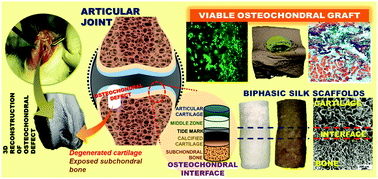Hierarchically structured seamless silk scaffolds for osteochondral interface tissue engineering†
Abstract
The osteochondral healthcare market is driven by the increasing demand for affordable and biomimetic scaffolds. To meet this demand, silk fibroin (SF) from Bombyx mori and Antheraea assamensis is used to fabricate a biphasic scaffold, with fiber-free and fiber-reinforced phases, stimulating cartilage and bone revival. The fabrication is a facile reproducible process using single polymer (SF), for both phases, designed in a continuous and integrated manner. Physicochemical and mechanical scaffold characterization, display interconnected pores with differential swelling and tunable degradation. The compressive modulus values, extend to 40 kPa and 25%, for tensile strain, at elongation. The scaffold support, for growth and proliferation of chondrocytes and osteoblasts, for respective cartilage and bone regeneration, is verified from in vitro assessment. Up-regulation of alkaline phosphatase (ALP) activity, extracellular matrix secretion and gene expression are significant; with acceptable in vitro immune response. Upon implantation in rabbit osteochondral defects for 8 weeks, the histological and micro-CT examinations show biphasic scaffolds significantly enhance regeneration of cartilage and subchondral bone tissues, as compared to monophasic scaffolds. The regenerated bone mineral density (BMD) ranges from 600–700 mg hydroxyapatite (HA) per cm3. The results, therefore, showcase the critically positive characteristics of in vitro ECM deposition, and in vivo regeneration of osteochondral tissue by this hierarchically structured biphasic scaffold.

- This article is part of the themed collection: Editor’s Choice: Scaffold Engineering


 Please wait while we load your content...
Please wait while we load your content...